| Reviews & Columns |
|
Reviews DVD TV on DVD Blu-ray 4K UHD International DVDs In Theaters Reviews by Studio Video Games Features Collector Series DVDs Easter Egg Database Interviews DVD Talk Radio Feature Articles Columns Anime Talk DVD Savant Horror DVDs The M.O.D. Squad Art House HD Talk Silent DVD
|
DVD Talk Forum |
|
|
| Resources |
|
DVD Price Search Customer Service #'s RCE Info Links |
|
Columns
|
|
|
Day the Earth Stood Still: Two-Disc Special Edition, The
Fox // Unrated // December 2, 2008
List Price: $19.98 [Buy now and save at Amazon]
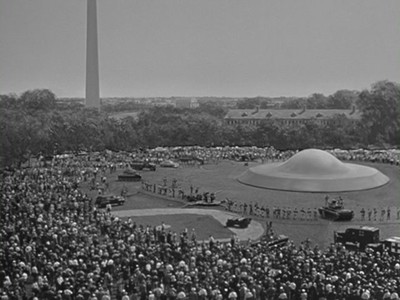 "It isn't faith that makes good science, Mr. Klaatu, it's curiosity. Sit down, please. There are several thousand questions I'd like to ask you." -- Prof. Barnhardt, The Day the Earth Stood Still |
The Film:
It's hard to imagine the science fiction genre as a whole without Robert Wise's The Day the Earth Stood Still. Blazing a trail for the genre early in the '50s, it would set the precedent -- and a near unobtainable benchmark -- for all other extra-terrestrial films to follow. Without it, would we have had either of Spielberg's cosmic fairytales, Close Encounters of the Third Kind and E.T., or even the entirety of Gene Roddenberry's Star Trek universe? It's possible, but they'd probably be very different. Even modern alien films like Independence Day wouldn't have a throwback reference, though some might consider a lack of "ID4" in the sci-fi mix to be a blessing.
Still, without the blueprints and ideas laid out by Wise's work, we wouldn't even have these popcorn flicks to cough up exuberant amount of cash to see in the Cineplex. But The Day the Earth Stood Still is far from being solely about other-worldly visitors; what gives it the longevity that still stretches to this day comes in the way it peers into humanity, especially our limited capacity to adapt to and understand concepts that reach outside our little bubbles. It's a masterwork of science fiction, but for a slew of intricate, intelligent reasons that you might not expect.
Wise's plot, based off of Harry Bates' story, is simple enough: a flying saucer has landed smack dab in the center of Washington, D.C., drawing scores of curious onlookers to its touchdown site. To the eyes of thousands upon thousands of nervous citizens, two entities step forth from the ship; one is a seemingly human individual instantly taken into custody, while the other is an ominous looking metal robot that, upon finding a spot outside of the U.F.O., has completely stopped moving -- as if awaiting orders. The human-like visitor, named Klaatu (Michael Rennie, The Lost World), has come to Earth for the sole purpose of warning about the impending doom that might come about if we neglect to cease our petty wars and development of element-based weapons.
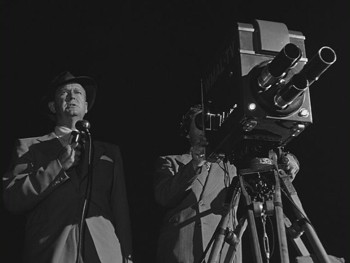 | 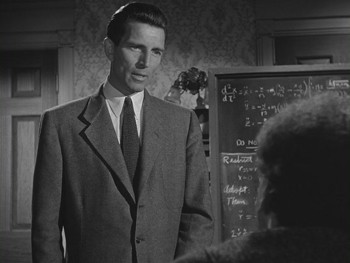 |
Operating as a critique for the post-WWII environment entrenched in the Cold War, The Day the Earth Stood Still can be quite deceptive if a glance or two is taken at its artwork, still shots, and the iconic, almost monolithic, stature of that metallic robot that it's become famous for. Assumptions could easily be made that this operates on a purely science fiction level, demonstrating death rays and ominous flying saucers as the Thermelin (the instrument used for the signature eerie '50s wobbly effect in the sound design) coats the surface. In fact, that's far from the case; Robert Wise's sci-fi picture operates on much more meaningful levels. It's these concepts that have kept it fresh -- and surprisingly relevant with today's societal conflicts -- over the years, which will probably continue for years to come if the globe doesn't latch onto some of its sprawling concepts.
One conversation held around a dining table earlier in the film features a group of characters discussing Klaatu and his presence on Earth, wondering why he might be here and for what purpose, or purposes. Suddenly, the gears shift in the conversation and a discussion arises that changes his status from being an alien to being a foreign spy -- which evokes even more fear and hostility than the idea of him being from another planet. There's one clear message that The Day the Earth Stood Still persistently communicates: in all our vast experience and untapped inexperience with the universe, there's an undeniable possibility that other human lifeforms exist on scattered planets -- and they might not be all about trying to ensnare the human race, capture loopy farmers for probing experiments, etc. Instead, it bluntly informs us of the ideal that humankind poses a much stronger threat than those curious other-worldly entities, along with the fact that they might be looking down on our pointless bickering with a smirk and a shaking of the head. There's a shaky, strained wire regarding global tension that Wise's film tightropes across, embodying the undertones of the time period that epitomizes post-McCarthy hysteria and activity in the nuclear disarmament effort.
But remember, this is a society fallen victim to the radio talents of Orson Welles' War of the Worlds, as he tricked the people into believing that the earth was under attack by aliens during his 1938 broadcast. In a similar, pre-WWII environment, people took the content at face value, believing that alien warfare was adding onto the already-tense situation. Media perception on both ends only highlights and intensifies mania, which also plays a rather sizable role in The Day the Earth Stood Still. When an ominous, disc-like object floats down to Earth and opens to reveal a ironclad robot with a human-like figure controlling it, the natural reaction could be fear -- or curiosity, or acceptance. Media's engineering of major events, however, aims for hysterics, which creates the pick-and-choose dynamic in telling people what to think and feel about the possibility of extra-terrestrial life. Wise's film opts to go the "fear" route, as most media outlets do, which leads to the cherry-picking of material to convey to the film's absorbent victims. It's a clear critique on mass-media and its manipulative nature, highlighted by subtle clues like the posturing of newscasters that relay the information and the excising of non-hysterical content from the crowd at the spacecraft's touchdown site.
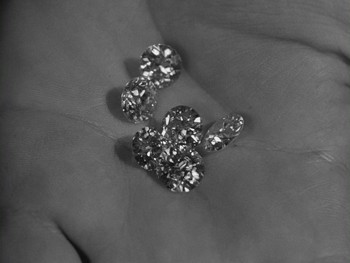 | 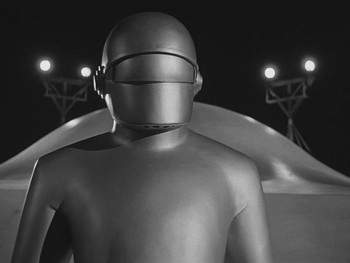 |
It's not just the themes that hold up well over the years, either. The Day the Earth Stood Still was crafted in 1951, a time when Hollywood was growing more and more experimental with crafting science fiction material on-screen in unique ways. Surprisingly, the careful techniques used in Wise's picture still look fantastic, from the presence of the flying saucer as it soars above and touchdowns within Washington D.C. to the usage of "death rays" pouring from the eyes of the ominous robot Gort. When the film begins to ramp up its sci-fi elements near the second half of the picture -- devoting the first half to building tension with its thematic poignancy -- it becomes both terrifying and engrossing to watch as the advanced methods of technological prowess flex their muscles on the world's overestimated grasp on technology's boundaries. Nowadays, computer generation can shatter and liquefy most types of matter while making just about any focal object fly; still, using simple techniques with found objects and camera tricks, there's tangibility that The Day the Earth Stood Still's production crew infuses into its stripped-down scenes that still work with full potency to this day -- which, in ways, can be seen as real magician's tricks instead of tech flexing its muscle.
More importantly, The Day the Earth Stood Still blends all these elements -- intelligence, tension, and curious whimsy heightened by technological awe -- into a hour-and-a-half of significant science-fiction entertainment that'll trump the effort of most modern films remotely in the same spectrum of genre. It's an important picture, especially during a time when tension has been mounted by the brewing, highly publicized threats of war and violence against each other. Even in a time when the efforts from science-fiction works like Forbidden Planet and the Star Trek television series have begun to show some significant rust, the seminal energy brooding in this '50s classic still stands as crisp and clean as Gort standing in front of his stunned onlookers. That's the sign of why The Day the Earth Stood Still is a truly great film -- the fact that you can pick it up more than fifty years later and it's still as polished and noteworthy as the day it was minted.
The DVD:
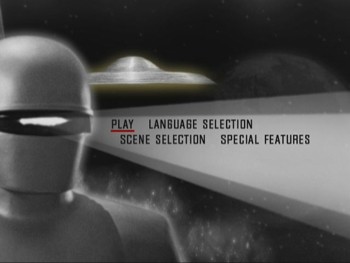 | 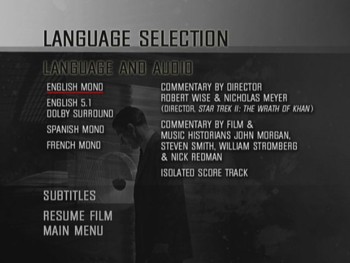 |
Note: The artwork for this release is NOT the one currently pictured on Amazon.com. It was changed to a more futuristic image that looks to mirror the color scheme used for the new 2008 remake of The Day the Earth Stood Still -- the motivation behind releasing a new, welcome edition that already had a solid product on the market.
Video and Audio:
Fox's 2002 release of The Day the Earth Stood Still came with a full-frame transfer that was -- and still is -- shockingly good for the time. Sharpness, grayscale range, digital noise, and print damage all were handled nicely. Hopefully it impressed those considering this purchase, because the transfer is, by and large, almost identical to the older edition. Since then, there have been some techniques utilized to capture a wider range of black-and-white shading in negatives, which can be scantly seen and minor corrections here and there throughout the image. Digital noise also appears a bit smoother, rendering minor background details with sharper lines and more solidified shades, as does the reduced level of edge enhancement. However, all of the damaged points in the print -- as scattered as they might be -- still crop up in this release. It's still a dandy transfer in itself, but upgrading this package based on the mildly tweaked visuals isn't much of a justification here. It's better, but only by a hair.
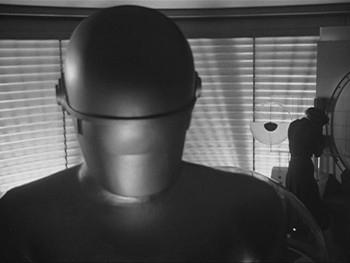 2002 Studio Classics | 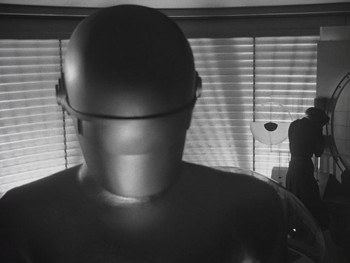 2008 Special Edition |
Extra Features:
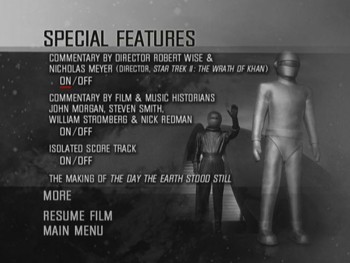 | 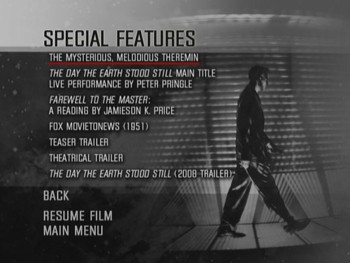 |
Sneak Peek at the 2008 Day the earth Stood Still:
Starting off the disc -- which is skippable, thank goodness -- is an expanded trailer-like peek into the 2008 remake of The Day the Earth Stood Still, starring Keanu Reeves and Jennifer Connelly.
Commentary with Robert Wise and Nicholas Meyer:
Starting immediately out of the gate with textual information, this is a highly informational and exceedingly dense commentary. It's not overly scene-specific as far as the flow goes, only reminding us here and there that they're actually going along with the film, but all the information that Wise regurgitates with Meyer moderating is astounding. It's more like listening to an interview instead of a commentary, but it's fascinating none the less. Once it reaches near the end of the track, it does grow more scene focused.
New Commentary with Host of Film and Music Historians:
Part of the big focus for this new special edition is concentrating on the music from the film, which gets intense focus here from John Morgan, Steven Smith, William Stromberg, and Nick Redman. They blend together music-specific material -- tones used in the score, specific instruments, etc -- with generic film-based impressions that they share, which offers a nice change of pace from straight musically-geared material. There's talk about how this score stands out more than others, ringing true with audiences that typically don't allow themselves to be magnetic to film music specifically.
Isolated Score Track:
As mentioned in the commentary, there's not an overwhelming amount of music present in The Day the Earth Stood Still. Because of this, there are very lengthy gaps of silence in this isolated track. However, when the musical elements kick into gear, it's hard not to get swept up in the entrancing nature of their eeriness and moody flutters. Moods match so well in this score, from the tracks present around the cemetery to the full-throttle tension pieces near the end of the film.
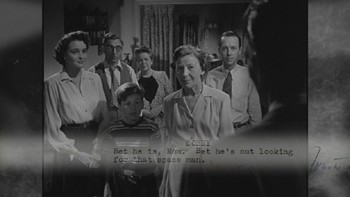 | 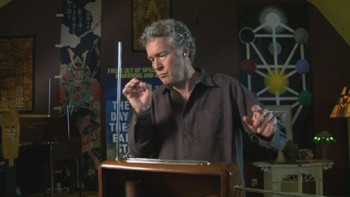 |
Making of The Day the Earth Stood Still:
Gone is the sluggish yet insightful 70-minute making-of featurette from the previous disc, replaced by this stronger, more focused featurette that primarily covers conceptualization and actor impressions regarding the film. It carries the commonplace footage/interview/still shot rhythm that's become the standard, but it also incorporates some archival recorded interviews that add a dash of quality material to the piece. It's not near as thorough as the Studio Collector piece, but it's much more digestible.
The Mysterious, Melodious Theremin (5:39):
Peter Pringle gives us the low-down on the Theremin, the signature musical instrument used to make that eerie high-pitched noise in '50s science fiction flicks. The best part of this featurette is the fact that the Theremin that Pringle is playing is the actual one used to compose the tracks for The Day the Earth Stood Still. It's an informative, neat featurette that outlines the history of the only instrument that you play without ever touching.
The Day the Earth Stood Still Live Performance (2:17):
Peter Pringle then goes on to play the two-minute introduction piece that starts out The Day the Earth Stood Still, strutting his skills to the paramount of his capabilities as he whisks his hands around the Theremin in entrancing fashion. Fun.
Farewell to the Master (41:27 + 29:32 + 25:59):
Harry Bates' short story as it originally appeared in publication is narrated by Jamieson K. Price in dramatic fashion. It'd probably be better to click off the television and sit back in listening to Price's voice, almost like listening to a radio broadcast.
Also included are a MovieTonewsNews Reel (6:51) , a Teaser Trailer, a Theatrical Trailer, and a Trailer for the 2008 Remake of The Day the Earth Stood Still.
On Disc 2:
 | 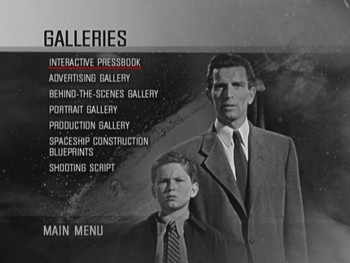 |
Decoding "Klaatu Barada Nikto" (16:11):
Probably the most memorable words from the film, this featurette deciphers the symbolism and meaning behind the words uttered from Klaatu in the film. Instantly, it kicks into a USA/Soviet discussion, as it starts to analyze the themes present regarding aggression and war in our world. It illustrates a latent desire in all of us for there to be an onlooking force from above that would break up te fight if it got too out of hand.
A Brief History of Flying Saucers (34:00):
Exactly as it says, this featurette hammers through the history of UFOs, the reports, and the types of people who report reported both false and true events. A slew of historians and scientists dive relatively deep into some of these occurrences, which feeds some of the curiosity sparked during the film to research some of the real events that have taken place. One interesting tidbit comes in a research project conducted at Harvard regarding hypnosis and the sensation/memory of alien abduction.
The Man Who Made the Earth Stand Still (14:43):
Edmund North, typically an anti-war film writer responsible for Patton as well, becomes the focus in this featurette. It slides through his history all the way to his younger years, chronicling his achievements and unique style via interview time with friends, colleagues, and family
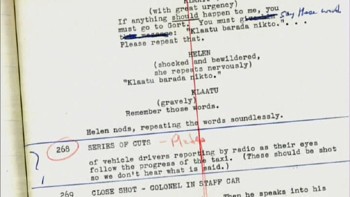 | 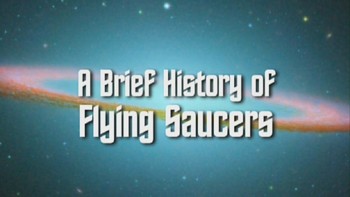 |
The Astounding Harry Bates (11:02):
Considering that a lot isn't really known about Harry Bates, the interviewees find plenty to discuss in this featurette of the author of The Day the Earth Stood Still's short story inspiration. It tells of his times at universities, as a sub-editor at a small magazine, and as one of the developers of Artounding Stories. Race to Oblivion:
Rounding out the featurettes, North's anti-war piece Race to Oblivion is included here. The quality's pretty rough, but you'll get the idea.
Interactive Pressbook:
Though it's included in the Galleries portion, this bonus feature deserves it sown separate recognition. Here, we've got a series of posters, newspaper clippings, and advertisements that can all be accessed by way of clicking with the remote to interact with each element. Textual information and photographs pop up at each click, which makes for a VERY lengthy, dense amount of reading regarding the film. It's a stellar design and extremely thorough.
Galleries:
Also included are a host of galleries, most of which come from the previous Studio Classics release. Here's a list of the categories as the break down: Advertising Gallery, Behind-the-Scenes Gallery, Portrait Gallery, Production Gallery, Spaceship Construction Blueprints, and Shooting Script.
Final Thoughts:
When it comes to alien/outer space visitor films, The Day the Earth Stood Still is the gold standard on how to take the material and make it serious, tense, and entertaining all in the same package. The fact that it laces its compelling science-fiction base with strong sociological and political critiques is icing on the cake, though some would consider this powerfully insightful material to be the cake in itself. Moreover, this classic from Robert Wise can still work as a popcorn-style '50s schlock film, sporting the enchanting sounds of the Theremin and the magnificently-executed effects that, though they show off their streamlined nature, still carry plenty of natural effectiveness in modern cinema. The Day the Earth Stood Still, in itself, comes with redundantly high recommendations -- especially if you're even remotely a fan of the sci-fi genre.
Fox's coordinated Two-Disc Special Edition, released with the theatrical showing of the 2008 remake, carries digital qualities that are largely similar to its predecessor Studio Classics disc. However, the sheer depth of supplements -- the additional commentary track, the focus on score, the elaboration of science fiction elements, and the sprawling insight into the filmmakers -- are where this new package for The Day the Earth Stood Still really earns its price tag. Which is incredibly low, starting at $20 and sure to be had for less. Since the price is extremely right and the supplements hit the sweet spot, it's very easy to Highly Recommend this budget package to just about everybody -- especially fans of the film left a little dry from the supplements in the Studio Classics release. Kudos to Fox for assembling a fantastic DVD.
|
| Popular Reviews |
| Sponsored Links |
|
|
| Sponsored Links |
|
|
| Release List | Reviews | Shop | Newsletter | Forum | DVD Giveaways | Blu-Ray | Advertise |
|
Copyright 2024 DVDTalk.com All Rights Reserved. Legal Info, Privacy Policy, Terms of Use,
Manage Preferences,
Your Privacy Choices | |||||||












